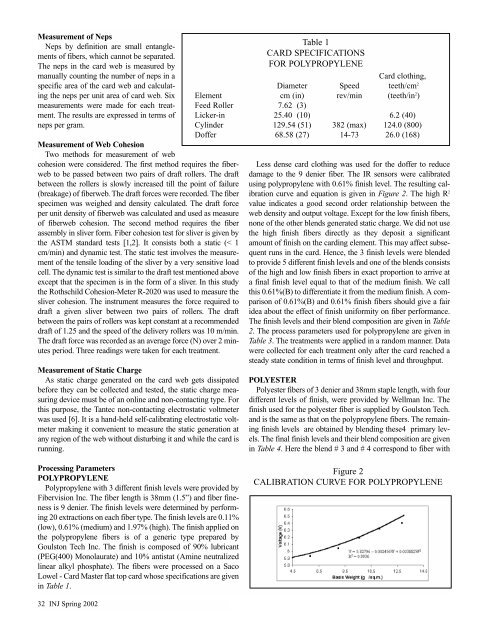2002 - Volume 1 - JEFF. Journal of Engineered Fibers and Fabrics
2002 - Volume 1 - JEFF. Journal of Engineered Fibers and Fabrics
2002 - Volume 1 - JEFF. Journal of Engineered Fibers and Fabrics
Create successful ePaper yourself
Turn your PDF publications into a flip-book with our unique Google optimized e-Paper software.
Measurement <strong>of</strong> Neps<br />
Neps by definition are small entanglements<br />
<strong>of</strong> fibers, which cannot be separated.<br />
The neps in the card web is measured by<br />
manually counting the number <strong>of</strong> neps in a<br />
specific area <strong>of</strong> the card web <strong>and</strong> calculating<br />
the neps per unit area <strong>of</strong> card web. Six<br />
measurements were made for each treatment.<br />
The results are expressed in terms <strong>of</strong><br />
neps per gram.<br />
Measurement <strong>of</strong> Web Cohesion<br />
Two methods for measurement <strong>of</strong> web<br />
cohesion were considered. The first method requires the fiberweb<br />
to be passed between two pairs <strong>of</strong> draft rollers. The draft<br />
between the rollers is slowly increased till the point <strong>of</strong> failure<br />
(breakage) <strong>of</strong> fiberweb. The draft forces were recorded. The fiber<br />
specimen was weighed <strong>and</strong> density calculated. The draft force<br />
per unit density <strong>of</strong> fiberweb was calculated <strong>and</strong> used as measure<br />
<strong>of</strong> fiberweb cohesion. The second method requires the fiber<br />
assembly in sliver form. Fiber cohesion test for sliver is given by<br />
the ASTM st<strong>and</strong>ard tests [1,2]. It consists both a static (< 1<br />
cm/min) <strong>and</strong> dynamic test. The static test involves the measurement<br />
<strong>of</strong> the tensile loading <strong>of</strong> the sliver by a very sensitive load<br />
cell. The dynamic test is similar to the draft test mentioned above<br />
except that the specimen is in the form <strong>of</strong> a sliver. In this study<br />
the Rothschild Cohesion-Meter R-2020 was used to measure the<br />
sliver cohesion. The instrument measures the force required to<br />
draft a given sliver between two pairs <strong>of</strong> rollers. The draft<br />
between the pairs <strong>of</strong> rollers was kept constant at a recommended<br />
draft <strong>of</strong> 1.25 <strong>and</strong> the speed <strong>of</strong> the delivery rollers was 10 m/min.<br />
The draft force was recorded as an average force (N) over 2 minutes<br />
period. Three readings were taken for each treatment.<br />
Measurement <strong>of</strong> Static Charge<br />
As static charge generated on the card web gets dissipated<br />
before they can be collected <strong>and</strong> tested, the static charge measuring<br />
device must be <strong>of</strong> an online <strong>and</strong> non-contacting type. For<br />
this purpose, the Tantec non-contacting electrostatic voltmeter<br />
was used [6]. It is a h<strong>and</strong>-held self-calibrating electrostatic voltmeter<br />
making it convenient to measure the static generation at<br />
any region <strong>of</strong> the web without disturbing it <strong>and</strong> while the card is<br />
running.<br />
Processing Parameters<br />
POLYPROPYLENE<br />
Polypropylene with 3 different finish levels were provided by<br />
Fibervision Inc. The fiber length is 38mm (1.5”) <strong>and</strong> fiber fineness<br />
is 9 denier. The finish levels were determined by performing<br />
20 extractions on each fiber type. The finish levels are 0.11%<br />
(low), 0.61% (medium) <strong>and</strong> 1.97% (high). The finish applied on<br />
the polypropylene fibers is <strong>of</strong> a generic type prepared by<br />
Goulston Tech Inc. The finish is composed <strong>of</strong> 90% lubricant<br />
(PEG(400) Monolaurate) <strong>and</strong> 10% antistat (Amine neutralized<br />
linear alkyl phosphate). The fibers were processed on a Saco<br />
Lowel - Card Master flat top card whose specifications are given<br />
in Table 1.<br />
32 INJ Spring <strong>2002</strong><br />
Table 1<br />
CARD SPECIFICATIONS<br />
FOR POLYPROPYLENE<br />
Card clothing,<br />
Diameter Speed teeth/cm 2<br />
Element cm (in)rev/min (teeth/in 2 )<br />
Feed Roller 7.62 (3)<br />
Licker-in 25.40 (10) 6.2 (40)<br />
Cylinder 129.54 (51) 382 (max) 124.0 (800)<br />
D<strong>of</strong>fer 68.58 (27) 14-73 26.0 (168)<br />
Less dense card clothing was used for the d<strong>of</strong>fer to reduce<br />
damage to the 9 denier fiber. The IR sensors were calibrated<br />
using polypropylene with 0.61% finish level. The resulting calibration<br />
curve <strong>and</strong> equation is given in Figure 2. The high R 2<br />
value indicates a good second order relationship between the<br />
web density <strong>and</strong> output voltage. Except for the low finish fibers,<br />
none <strong>of</strong> the other blends generated static charge. We did not use<br />
the high finish fibers directly as they deposit a significant<br />
amount <strong>of</strong> finish on the carding element. This may affect subsequent<br />
runs in the card. Hence, the 3 finish levels were blended<br />
to provide 5 different finish levels <strong>and</strong> one <strong>of</strong> the blends consists<br />
<strong>of</strong> the high <strong>and</strong> low finish fibers in exact proportion to arrive at<br />
a final finish level equal to that <strong>of</strong> the medium finish. We call<br />
this 0.61%(B) to differentiate it from the medium finish. A comparison<br />
<strong>of</strong> 0.61%(B) <strong>and</strong> 0.61% finish fibers should give a fair<br />
idea about the effect <strong>of</strong> finish uniformity on fiber performance.<br />
The finish levels <strong>and</strong> their blend composition are given in Table<br />
2. The process parameters used for polypropylene are given in<br />
Table 3. The treatments were applied in a r<strong>and</strong>om manner. Data<br />
were collected for each treatment only after the card reached a<br />
steady state condition in terms <strong>of</strong> finish level <strong>and</strong> throughput.<br />
POLYESTER<br />
Polyester fibers <strong>of</strong> 3 denier <strong>and</strong> 38mm staple length, with four<br />
different levels <strong>of</strong> finish, were provided by Wellman Inc. The<br />
finish used for the polyester fiber is supplied by Goulston Tech.<br />
<strong>and</strong> is the same as that on the polypropylene fibers. The remaining<br />
finish levels are obtained by blending these4 primary levels.<br />
The final finish levels <strong>and</strong> their blend composition are given<br />
in Table 4. Here the blend # 3 <strong>and</strong> # 4 correspond to fiber with<br />
Figure 2<br />
CALIBRATION CURVE FOR POLYPROPYLENE

















